Biology 103 exam - Study guides, Class notes & Summaries
Looking for the best study guides, study notes and summaries about Biology 103 exam? On this page you'll find 151 study documents about Biology 103 exam.
All 151 results
Sort by

-
Biology 103 Exam 1 Questions and Answers Already Passed
- Exam (elaborations) • 9 pages • 2024
-
- $9.99
- + learn more
Biology 103 Exam 1 Questions and Answers Already Passed **What are tiny entities of matter called?** **** Subatomic particles, which include protons, neutrons, and electrons. **What is the basic unit of all substances?** **** Atoms are the building blocks of all substances. **What term describes a group of atoms bonded together?** **** Molecules. **What are organized or specialized structures within a living cell called?** **** Organelles. **What is the smallest living unit of life?** ...
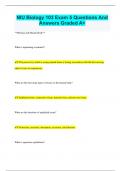
-
NIU Biology 103 Exam 5 Questions And Answers Graded A+
- Exam (elaborations) • 10 pages • 2024
-
Available in package deal
-
- $9.99
- + learn more
NIU Biology 103 Exam 5 Questions And Answers Graded A+ **Biology and Human Body** What is imprinting in animals? The process by which a young animal forms a lasting association with the first moving object it sees or experiences. What are the four main types of tissues in the human body? Epithelial tissue, connective tissue, muscle tissue, and nervous tissue. What are the functions of epithelial tissue? Protection, secretion, absorption, excretion, and filtration. ...
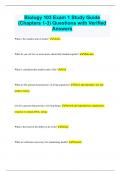
-
Biology 103 Exam 1 Study Guide (Chapters 1-3) Questions with Verified Answers
- Exam (elaborations) • 11 pages • 2024
- Available in package deal
-
- $9.99
- + learn more
Biology 103 Exam 1 Study Guide (Chapters 1-3) Questions with Verified Answers What is the smallest unit of matter? Atoms What do you call two or more atoms chemically bonded together? Molecules What is considered the smallest unit of life? Cell What are the general characteristics of living organisms? Grow and reproduce; use and produce energy List five general characteristics of living things. Growth and reproduction, organization, response to stimuli, DNA, energy What i...
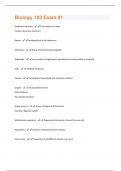
-
Biology 103 Exam #1 Questions and Answers 2024;full solution pack
- Exam (elaborations) • 5 pages • 2024
- Available in package deal
-
- $7.99
- + learn more
Subatomic particles - Tiny entities of matter Protons, Neutrons, Electrons Atoms - Building block of all substances Molecules - Group of atoms bonded together Organelles - Any number of organized or specialized structures within a living cell Cells - Smallest living unit Tissues - Consisting of specialized cells and their products Organs - Structural/functional Self-contained Has specific functions Organ systems - Group of organs with functions Example: digestive system Multicellular...
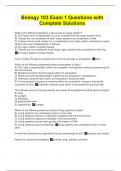
-
Biology 103 Exam 1 Questions with Complete Solutions
- Exam (elaborations) • 11 pages • 2024
-
Available in package deal
-
- $9.99
- + learn more
What is the difference between a tissue and an organ system? A) The tissue level of organization is more inclusive than the organ system level. B) Tissues are not composed of cells; organ systems are composed of cells. C) A tissue cannot exist unless it is a component of an organ system, whereas an organ system can exist independently of tissues. D) An organ system includes tissues. E) Tissues are not considered to be living; organ systems are considered to be living. an organ system includes ti...
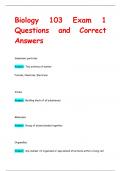
-
Biology 103 Exam 1 Questions and Correct Answers
- Exam (elaborations) • 11 pages • 2024
- Available in package deal
-
- $9.79
- + learn more
Subatomic particles Answer: Tiny entities of matter Protons, Neutrons, Electrons Atoms Answer: Building block of all substances Molecules Answer: Group of atoms bonded together Organelles Answer: Any number of organized or specialized structures within a living cell Cells Answer: Smallest living unit Tissues Answer: Consisting of specialized cells and their products Organs Answer: Structural/functional Self-contained Has specific functions Organ systems Answer: Group of organs...
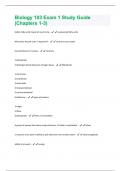
-
Biology 103 Exam 1 Study Guide (Chapters 1-3) Questions And Answers With Latest Solutions
- Exam (elaborations) • 7 pages • 2024
-
- $7.99
- + learn more
better, fatty acids; liquid at room temp - unsaturated fatty acids What does the pH scale 7 represent? - neutral or pure water (neutral) found in nucleus - neutrons 1) phosphate 2) hydrogen bonds between nitrogen bases - DNA Bonds 1) structural 2) nutritional 3) enzymatic 4) transportational 5) communicational 6) defensive - types of proteins 1) sugar 2) base 3) phosphate - Parts of nucleotides A group of species that share unique features. 1st letter is capitalized. - Genus a mea...
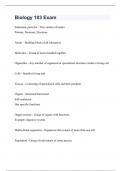
-
Biology 103 Exam
- Exam (elaborations) • 6 pages • 2024
-
Available in package deal
-
- $12.99
- + learn more
Subatomic particles - Tiny entities of matter Protons, Neutrons, Electrons Atoms - Building block of all substances Molecules - Group of atoms bonded together Organelles - Any number of organized or specialized structures within a living cell Cells - Smallest living unit Tissues - Consisting of specialized cells and their products Organs - Structural/functional Self-contained Has specific functions Organ systems - Group of organs with functions Example: digestive syste...

-
Biology 103 Exam #1 Questions And Answers With 100% Correct Answers
- Exam (elaborations) • 5 pages • 2024
-
- $7.99
- + learn more
Unsaturated - Liquid at room temperature Double bond between some Carbon Organ systems - Group of organs with functions Example: digestive system 4 levels of proteins - 1. Primary: sequences of amino acids 2. Secondary: folding by H bonds 3. Tertiary: another "folding process" 4. Quaternary: 2 or more amino acids Atoms - Building block of all substances Attributes/characteristics of living organisms - 1. Composed Cell 2. Highly organized and complex 3. Use Energy 4. Grow, develop, ...
Biology 103 Exam Questions and Correct Answers

Did you know that on average a seller on Stuvia earns $82 per month selling study resources? Hmm, hint, hint. Discover all about earning on Stuvia



